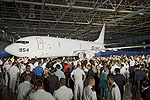Boeing Rolls Out US Navy's P-8A Poseidon
 SEATTLE, July 30, 2009 -- The Boeing Company [NYSE: BA] and the U.S. Navy today formally unveiled the service's newest maritime patrol and reconnaissance aircraft, the P-8A Poseidon, during a ceremony at the Boeing facility in Renton, Wash.
SEATTLE, July 30, 2009 -- The Boeing Company [NYSE: BA] and the U.S. Navy today formally unveiled the service's newest maritime patrol and reconnaissance aircraft, the P-8A Poseidon, during a ceremony at the Boeing facility in Renton, Wash.
A derivative of the Next-Generation 737-800, the P-8A is a long-range anti-submarine warfare, anti-surface warfare, intelligence, surveillance and reconnaissance aircraft capable of broad-area, maritime and littoral operations.
"The P-8A Poseidon will equip the U.S. Navy with the most advanced multi-mission maritime patrol and reconnaissance aircraft in the world," said Jim Albaugh, president and CEO of Boeing Integrated Defense Systems. "The Poseidon is also the latest in a decades-long Boeing tradition of working closely with the Navy and other customers to deliver a wide range of platforms that meet their most critical mission requirements, including commercial-derivative military planes, fighters, rotorcraft, and attack, electronic warfare and unmanned aircraft."
As the replacement for the Navy's P-3C Orion aircraft, the P-8A will provide greater payload capacity, significant growth potential, unprecedented flexibility and interoperability, and advanced mission systems, software and communications.
"The P-8A program is an outstanding example of evolutionary acquisition at work," said Capt. Mike Moran, U.S. Navy Maritime Patrol and Reconnaissance Aircraft program manager. "The team has worked hard to stay on schedule and within cost in this development effort, and we all should be extremely proud of the results."
The P-8A is built by a Boeing-led industry team that includes CFM International, Northrop Grumman, Raytheon, Spirit AeroSystems and GE Aviation. The team currently is assembling and testing the first five P-8As as part of the program's System Development and Demonstration contract, awarded in 2004.
The integrated Navy/Boeing team will begin formal flight testing of the P-8A later this year. The Navy plans to purchase 117 P-8As, and initial operational capability is planned for 2013.